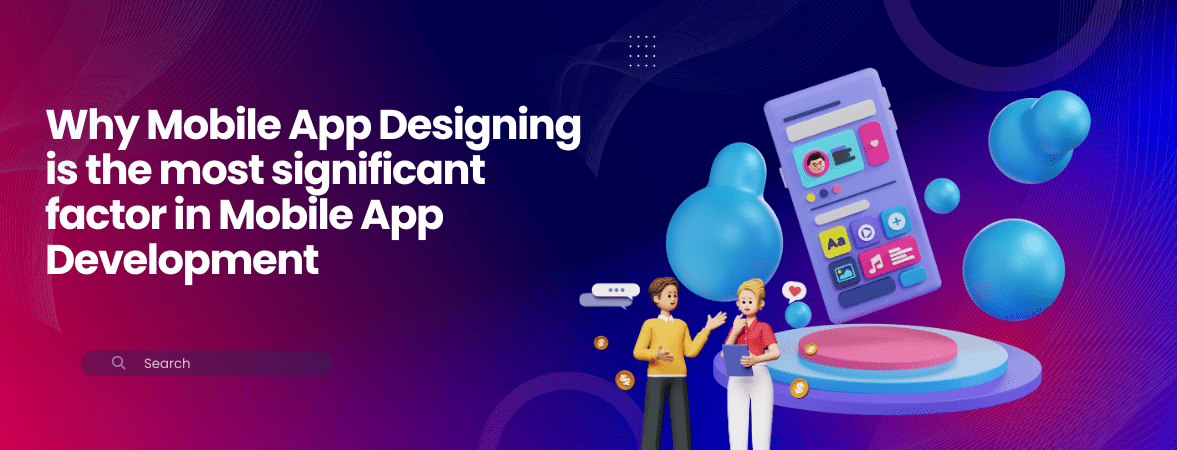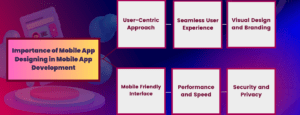
Quick Summary: This blog delves into the significance of app design by discussing some vital elements like user-centric approach, seamless experience, visual identity and more that influence the development process.

Mobile app design plays a pivotal role in facilitating an intuitive user experience and engaging interface, making it one of the most critical aspects of mobile app development. With the immense competition in today’s app markets, it is important for any mobile app design company to focus keenly on crafting designs that prioritize key aspects like usability, branding and performance to attract and retain users. This blog delves into the significance of app design by discussing some vital elements like user-centric approach, seamless experience, visual identity and more that influence the development process.
Mobile app design refers to the process of creating visual layouts, user interfaces and experiences that are tailored to suit the unique characteristics of mobile platforms. An optimized mobile design focuses on aspects like screen sizes, input methods, connectivity dependencies and performance limitations of mobile devices. The primary goal of mobile app design is to enable comfortable usability and accomplishment of key tasks as seamlessly as possible within the constraints of mobile.
Effective mobile app design involves crafting thoughtful user flows and navigation patterns, intuitive interactions, consistent branding and aesthetics as well as strategic use of white space, text sizes, imagery and animation. It holistically addresses concerns like one-handed use, varying connectivity speeds and intermittent access to data. Well-designed app icons, onboarding tutorials, in-app messaging and error handling are also important to facilitate adoption and retention. With diverse types of mobile devices in the market, designing apps which provide similar experiences across platforms further adds to the complexity of designing great mobile experiences.
Here are some key reasons why mobile app design is important in mobile app development:

A user-centric design process ensures that the mobile app is developed with the user’s goals and needs in focus. Any reputable mobile app design company knows that taking a user-centered view is essential for building intuitive and effective interfaces. Comprehensive user research is conducted right from the beginning to understand how users currently perform tasks and what challenges they face. Inputs are gathered through surveys, interviews and observational studies on how people currently use similar apps or websites. This helps identify key pain points and prioritize important features to be incorporated.
With deep insights about the target users, prototypes are created and user testing is done iteratively. A user-centric design approach allows users to provide feedback on early versions which leads to refinements. This continues till an optimal solution is arrived at that aligns with real user needs and capabilities. Continued user research even post-launch provides valuable data to further improve the mobile experience over time. Focusing on true user-centered design from the start helps create intuitive, purposeful experiences. It ensures users can easily accomplish tasks through seamless interactions within the app.
Providing a seamless user experience is a key priority for any application design company. A good mobile experience keeps users engrossed through consistent and intuitive interactions. Navigation within the app should feel natural with just the right amount of animation, feedback and visual cues integrated. Page transitions, loading states, gestures and onboarding processes need to be polished to optimize usability. Frictionless transitions allow users to flow freely between tasks. Responsive and adaptive design also ensures a smoother experience across different form factors.
Continuous usability testing identifies pain points to be ironed out. For example, limiting loading spinners, reducing page refreshes, optimizing for slow networks etc remove unnecessary hassles. Streamlined workflows let users complete tasks quicker. User experience design considerations such as personalization, accessibility and content prioritization further enhance engagement. A well-implemented user experience drives satisfaction and loyalty. Users tend to spend more time within an app and use it more frequently if the experience feels pleasurable. This ultimately boosts business metrics like conversions, retention and revenues for the application.
Visual design plays a crucial role in introducing any brand through a mobile application. A reputed application design company focuses heavily on crafting an aligned visual identity for target audiences. Cohesive use of colours, imagery, graphics and typography help set the right tone and communicate the brand effectively. These elements come together to create an aesthetic that leaves a memorable first impression on users. The visual language stays consistent across different platforms to build recognition. Identifiable icons, illustrations and animations reinforce the brand even in small glances. Well-designed visual assets improve retention of logos, taglines and core messaging.
Clear branding through visuals has proven beneficial impacts for user acquisition and loyalty. It builds credibility and trust in the application. Users are attracted to apps that portray professionalism through appearance. Positive emotions are invoked which makes users want to spend more time exploring features. In turn, this increases engagement metrics and retention rates. For any application design company, visual branding plays a large role in not just drawing users in but keeping them loyal to the platform in the long run.
Developing a responsive interface is a key focus area for any reputable mobile app design company. With mobile usage surpassing desktops globally, it has become imperative for applications to work seamlessly across different device sizes and platforms. A responsive design adapts the interface, layout and interactions based on varying screen widths. This ensures an optimized experience for users on diverse form factors including smartphones as well as tablets. Text, images, navigation and controls adjust appropriately to suit individual displays avoiding the need for specific tablet or phone versions.
Usability testing on multiple form factors helps identify readability or readability issues beforehand. User experience is further enhanced by factors like touch target sizing, single hand operation support, scrolling performance etc. A fluid and coherent interface across varying screen widths has proven benefits in terms of satisfaction, retention and downloads. It eliminates friction for users by eliminating pinching, zooming or scrolling to consume content. Adaptability builds confidence in the app’s compatibility and creates an inclusive experience for all user segments. A responsive design approach is therefore vital for any mobile app design company to satisfy diverse user needs.
In the highly competitive app markets, performance and speed have become critical factors for user satisfaction and retention. A mobile app design company knows users have a low tolerance for slow apps in this era of instant gratification. It is therefore important for applications to load quickly, respond efficiently to taps and swipes, and display animations smoothly. Optimizing for a small file size, limited dependencies and minimal resource usage helps apps feel fast and lightweight even on lower-end devices. Addressing lag, jank and redrawing issues through techniques like image optimization and lazy loading improves overall responsiveness.
Usability testing tools provide insights to troubleshoot bottlenecks. Performance audits identify resource-hungry sections to optimize further. Caching, deferred loading and prioritization according to usage patterns enhances the experience. A fast app that feels snappy improves conversion of users at each stage. It elicits positive emotions and makes the brand seem reliable. Speed also contributes to business metrics like reduced bounce rates and increased time spent in-app. For users on constrained mobile connections, optimized performance is a crucial factor for deciding to continue using an application. It positively impacts overall engagement and satisfaction long-term.
Security and privacy are among the biggest concerns for users when using any mobile application today. A mobile app design company needs to recognize this and ensure the highest standards of security and privacy are incorporated into their designs from the very beginning. Key aspects like authentication protocols, password policies, encryption of sensitive data, and permissions management need to be thought through carefully during the design phase itself.
Appropriate strategies must be employed to prevent unauthorized access and vulnerabilities. The design should allow users to view and control what personal information an app can access as well as restrict sensitive features based on location, peer presence, and other contextual factors. Simple yet powerful in-app privacy dashboard experiences can also be built to establish trust among users that their data remains protected. Failure to embed privacy and data protection as a core design principle could drastically hurt an app’s credibility and adoption over time.
A user-centered design philosophy focusing keenly on the above discussed priorities ensures that mobile apps are developed with users’ needs and goals at the forefront. Comprehensive design execution leads to enhanced usability, engagement and business outcomes. While technology continues to evolve rapidly, the core principles of intuitive interactions, visual appeal and optimized performance remain unchanged in their importance. For any reputable mobile app design company, emphasizing design excellence throughout the development cycle will continue delivering richer mobile experiences that satisfy users and help achieve long-term success.
Join our growing community and get inspiring articles.
Our highly trained talented teams are committed to providing you with top-level, technical or any other support 24*7.
Ready to get started? Give us a call.